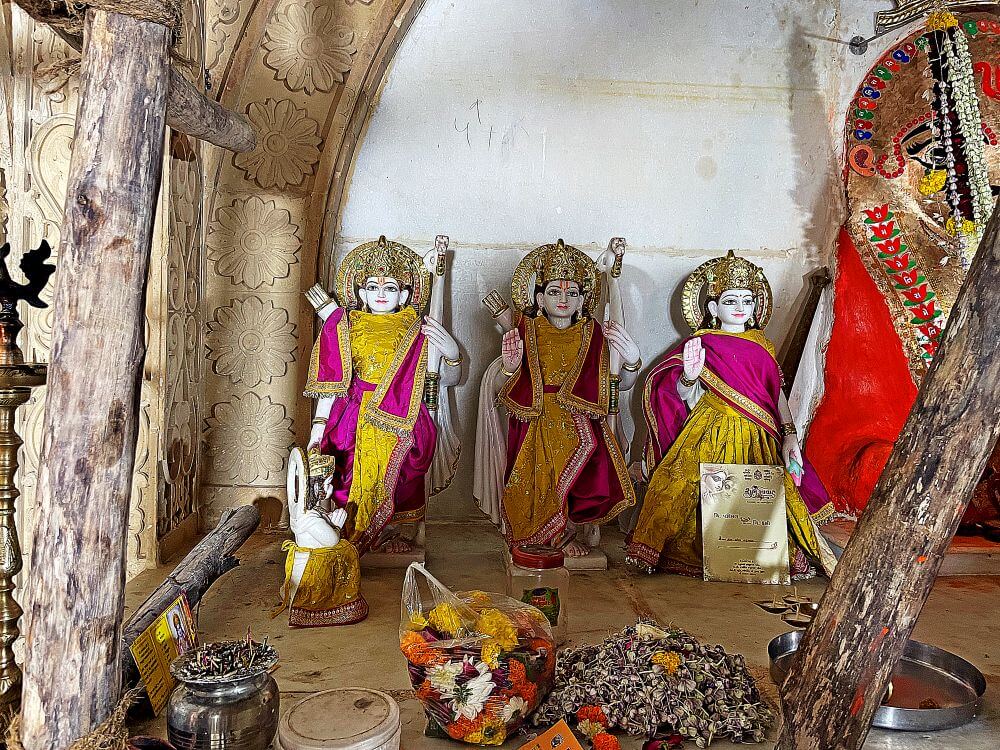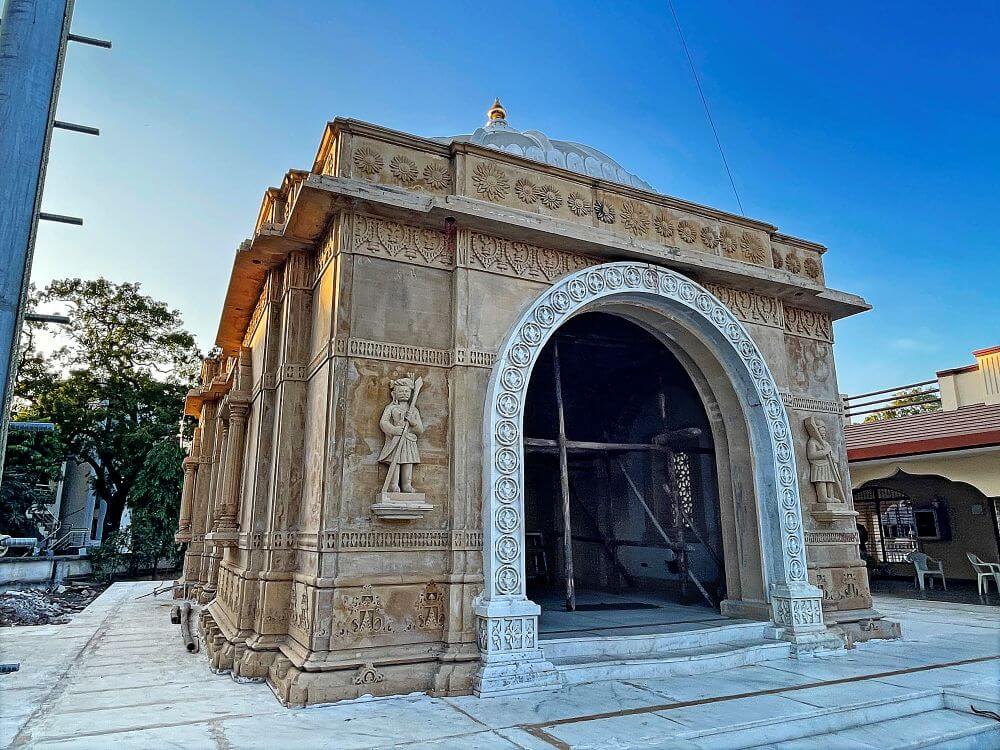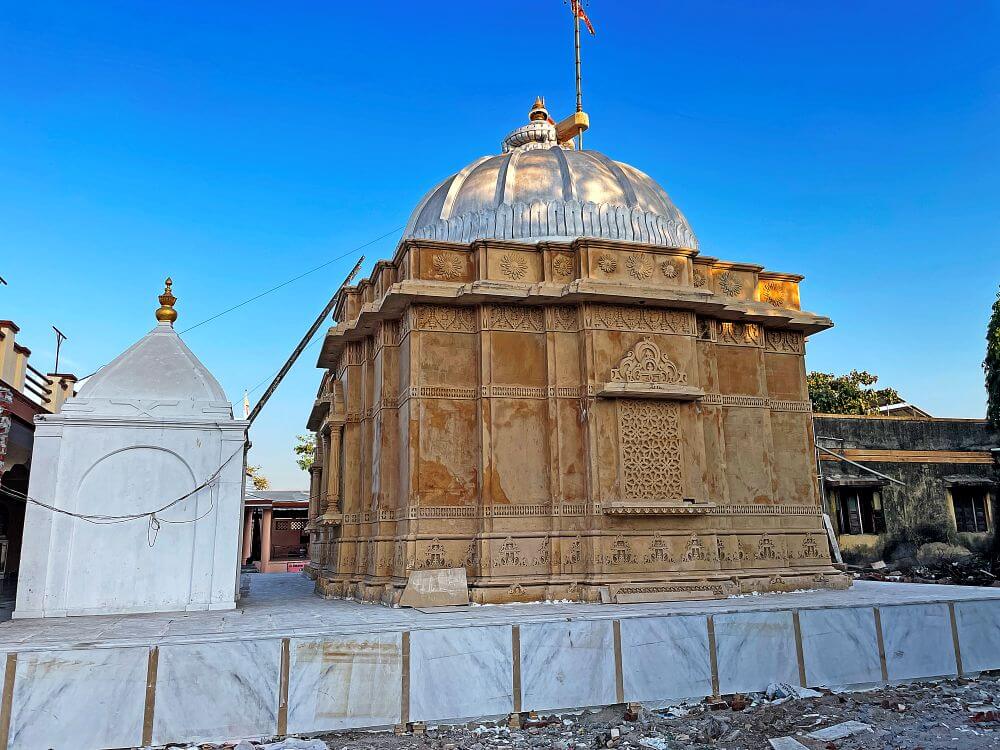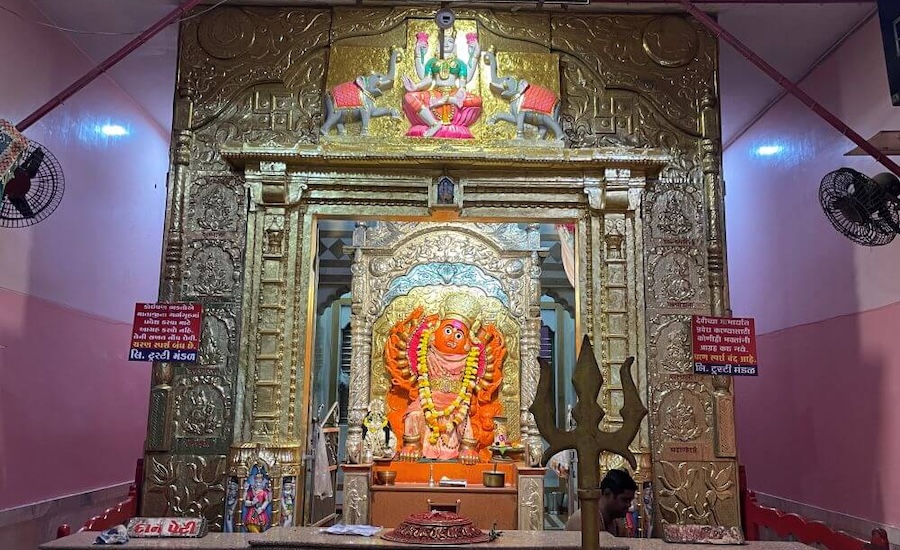
‘All afflictions, spirits and worries are destroyed at Bhimdarshan, bringing joy’ (भूतप्रेतसमंधादी रोगव्याधी समस्तही। नासती तुटती चिंता आनंदे भीमदर्शने।।) with these words, Samarth Ramdas Swami praised Lord Hanuman as the mighty protector and life-giver. A sacred and ancient site of Hanuman is located in Bhimpor, known as the Juna Hanumanji Temple. Devotees strongly believe that Hanuman here is awakened (Jagrut) and that his darshan cures chronic ailments, particularly helping children overcome speech impediments and stammering through the offering of prasadam.
Located about 5 km from Dumas near Surat, Bhimpor was once a small village under the Chaulukya Empire (10th–13th centuries). In the 15th century, Surat came under the Muslim Sultanate of Gujarat and Bhimpor became part of it. The area endured several natural and political calamities, including a massive plague in 1790–1791, which claimed nearly 100,000 lives in Surat, also affecting nearby villages like Bhimpor. The villagers believe that the Hanuman idol enshrined here for over 350 years has protected them through all such adversities. This belief has led to deep-rooted devotion among the local community.
 The ancient temple, known as Bhimporiya Hanuman Mandir, has undergone several renovations over the years. The most recent restoration has given the temple its current grand appearance. It is situated in a large courtyard adjacent to the main road of the village, enclosed by a tall boundary wall. The temple structure is impressive and spacious. At the front, there is a single-storey entrance building with a veranda (Owari). Entry into the temple courtyard is through this gateway. Upon entering, to the left side, there is a shrine dedicated to Baliyadev.
The ancient temple, known as Bhimporiya Hanuman Mandir, has undergone several renovations over the years. The most recent restoration has given the temple its current grand appearance. It is situated in a large courtyard adjacent to the main road of the village, enclosed by a tall boundary wall. The temple structure is impressive and spacious. At the front, there is a single-storey entrance building with a veranda (Owari). Entry into the temple courtyard is through this gateway. Upon entering, to the left side, there is a shrine dedicated to Baliyadev.
A short distance ahead, there is a small temple of Lord Shankar. In front of this temple stand marble idols of Nandi (the sacred bull) and a tortoise, facing a serene idol of Lord Shivshankar placed on a raised platform. 
Nearby, there is another temple dedicated to Shivshankar. On either side of the sanctum entrance, the left shrine houses an idol of Ganesha, while the right shrine contains an idol of Hanuman. Inside the marble sanctum, in front of the Shivalinga, sits Nandi. A serpent (Naga) forms a hooded canopy over the Shivalinga and a copper vessel above continuously drips water or sacred liquid onto the linga for abhishekam. Around the umbrella-like structure above the linga, rudraksha garlands are suspended. On the rear wall of the sanctum, there is an idol of Goddess Parvati.
Within the temple premises, there is also a Sai Baba temple, located directly opposite the grand Hanuman temple, which is the main shrine of the complex. 
The temple consists of a sabhamandap (assembly hall) and a garbhagriha (sanctum sanctorum). The sabhamandap has an entrance with a semi-circular arched doorway, adorned with attractive carvings. On both sides of the entrance walls are sculptures of doorkeepers (dwarapalas). The sabhamandap is spacious, featuring large latticed windows that allow ample light and ventilation. The interior walls are decorated with delicate carvings. The sanctum at the front is completely open from the front side. Inside the sanctum, on a tall marble pedestal, stands a large stone idol of Hanuman, with a smaller stone idol of Hanuman placed beside it. Both idols are high-relief sculptures coated in vermilion (shendur). Their faces are painted with eyes, mouth and mustache and both wear golden crowns on their heads.  Below and to the left of the Hanuman idols, there are idols of Ram, Lakshman and Seeta. Beside them, to the left, is a small idol of Hanuman (Pawansut) shown in a reverent pose, paying homage to the divine trio.
Below and to the left of the Hanuman idols, there are idols of Ram, Lakshman and Seeta. Beside them, to the left, is a small idol of Hanuman (Pawansut) shown in a reverent pose, paying homage to the divine trio.
Children who are unable to speak even after the age of four or those who stammer are especially brought by their parents to this Hanuman temple. Vows (navas) are made to Hanuman so that the children may begin to speak clearly or overcome their speech impediments. As part of the ritual, parents bring jaggery (gur) as an offering. The temple priest places this jaggery in the mouth of Hanuman’s idol, blesses it and then returns it to the parents. Devotees believe that feeding a small portion of this blessed jaggery to the child daily helps the child begin speaking clearly.  Even devotees living abroad request the prasadam by post and feed it to their children. It is said that once the child starts speaking, it becomes obligatory to bring the child for Hanuman’s darshan.
Even devotees living abroad request the prasadam by post and feed it to their children. It is said that once the child starts speaking, it becomes obligatory to bring the child for Hanuman’s darshan.
Devotees also believe that Hanuman at this temple cures chronic and incurable diseases. As a result, thousands of devotees from across Gujarat, Maharashtra, Delhi and other regions come to seek blessings.
At this temple, devotees can have darshan from Sunday to Friday, between 6:00 AM to 12:00 PM and again from 4:00 PM to 8:00 PM. On Saturdays, darshan is available from 6:00 AM to 9:00 PM. On the occasion of Hanuman Jayanti, a large number of devotees visit the temple. Special events such as Hanuman Yajna, processions (shobhayatra), distribution of Mahaprasad and devotional music evenings (bhajan sandhya) are organized on this day. In addition to Hanuman Jayanti, the temple also celebrates Ganesh Chaturthi and various other Hindu festivals with great enthusiasm.



